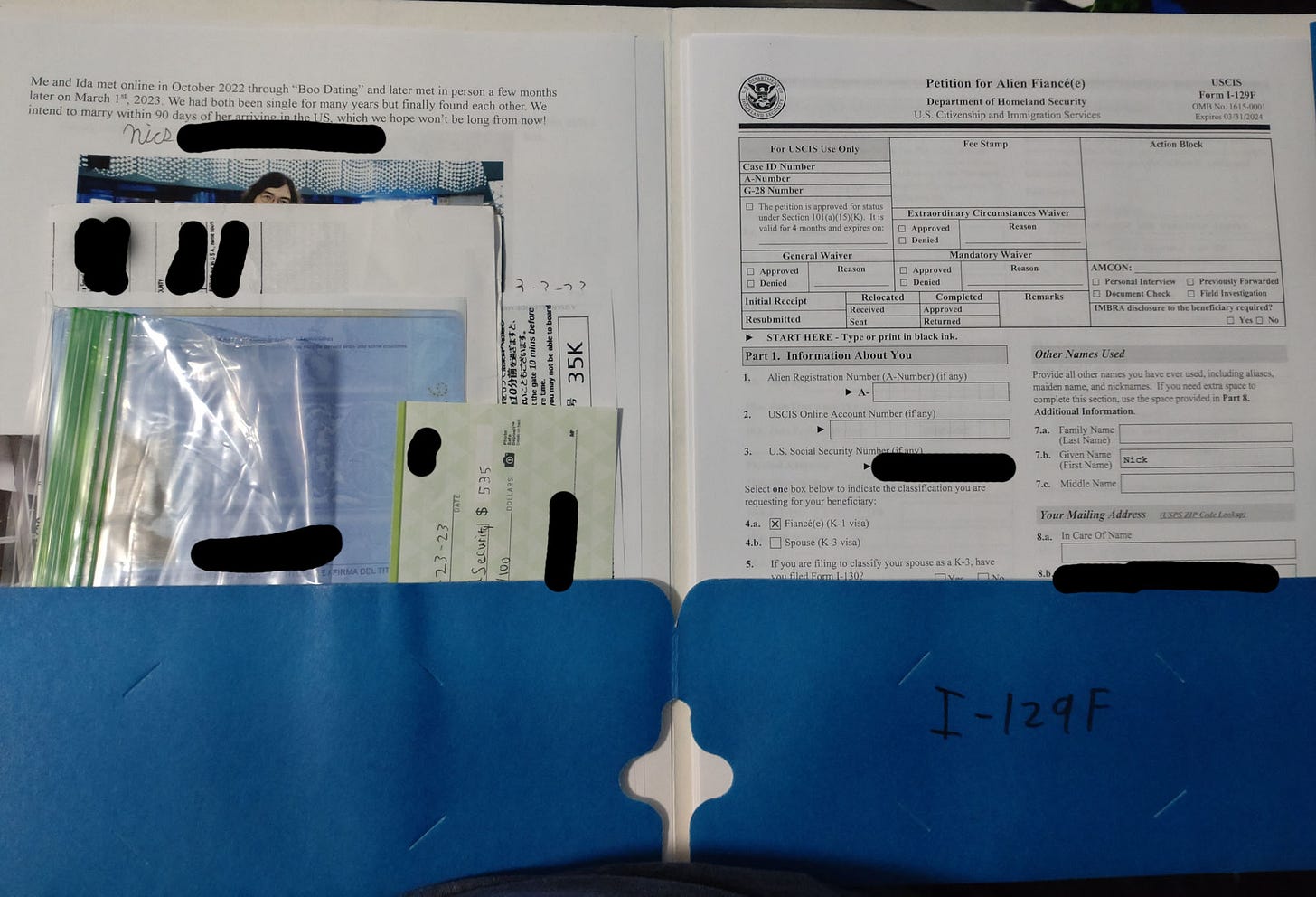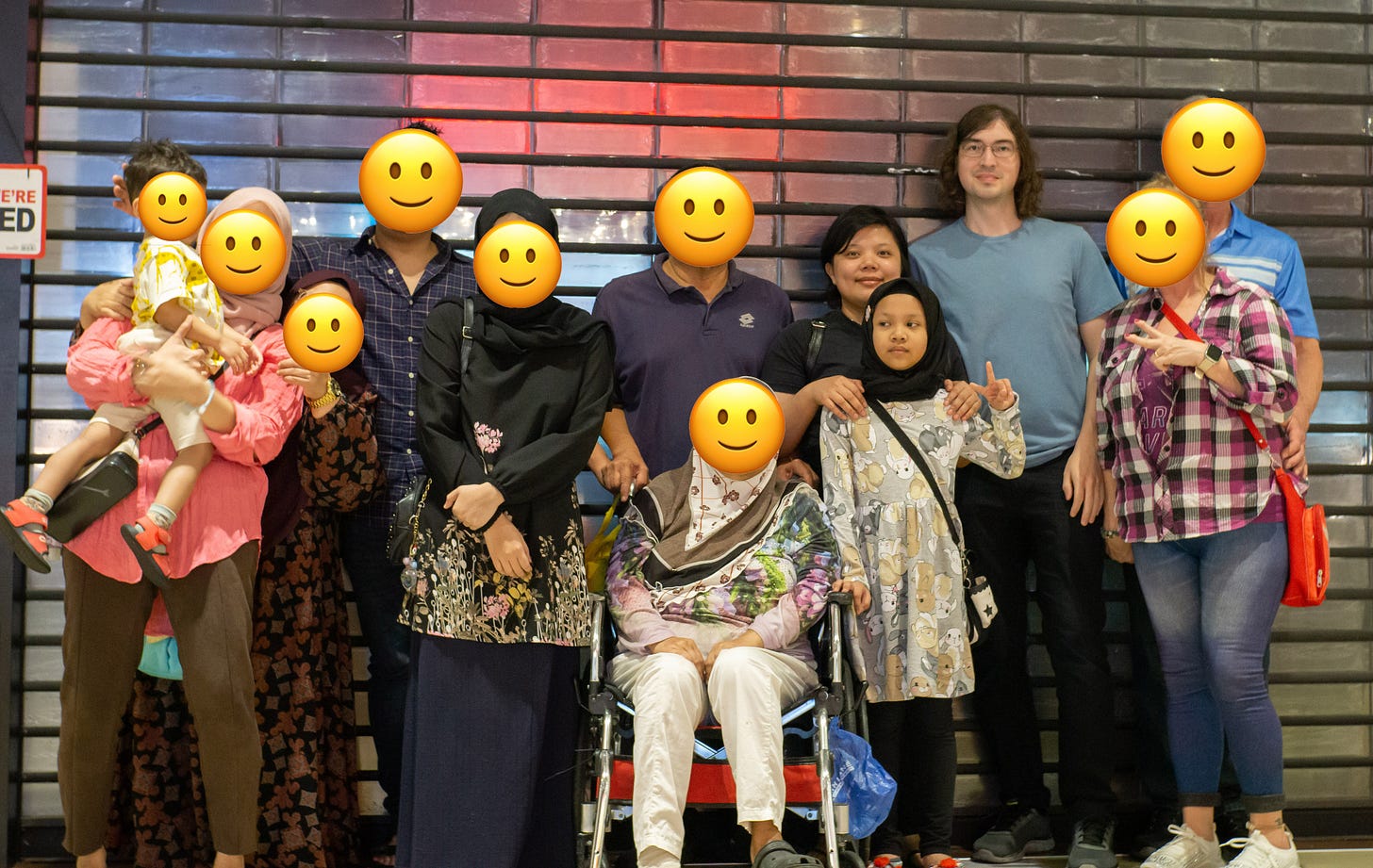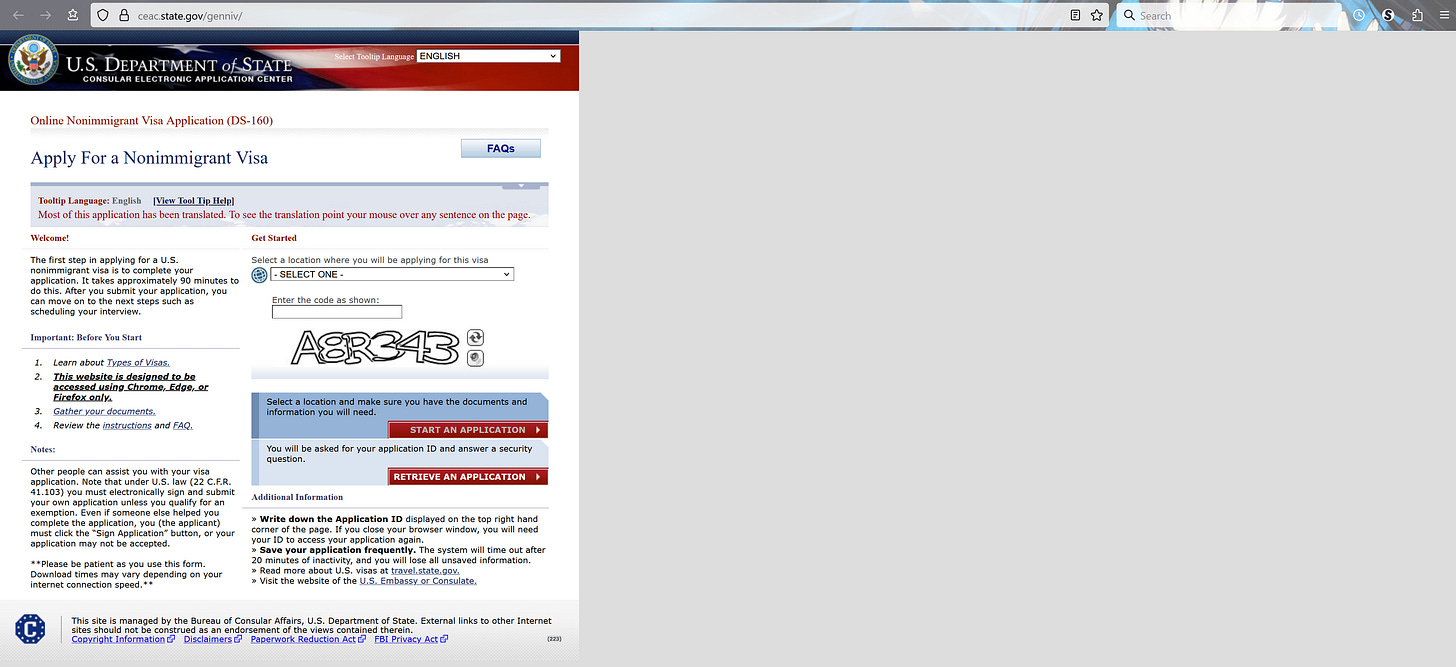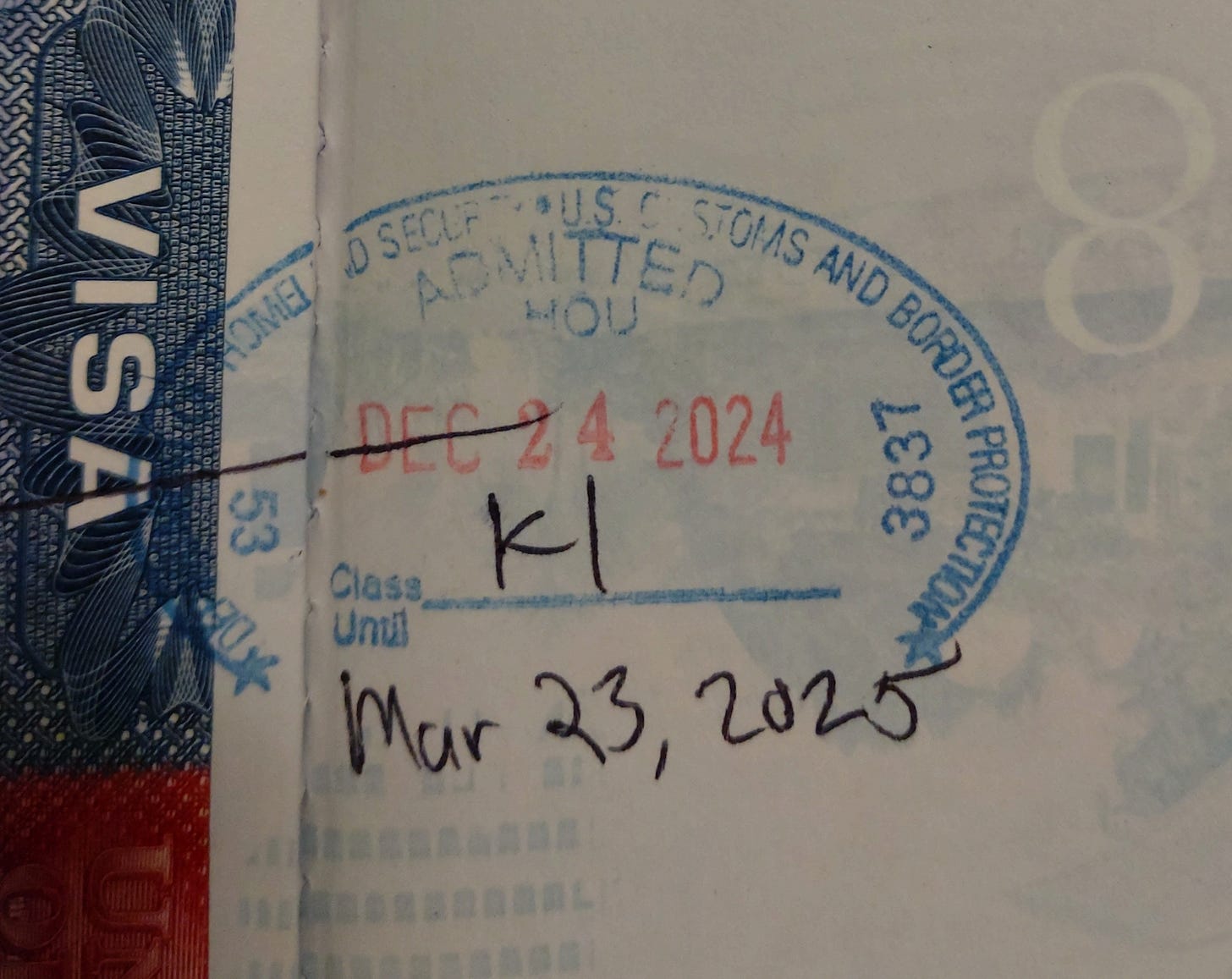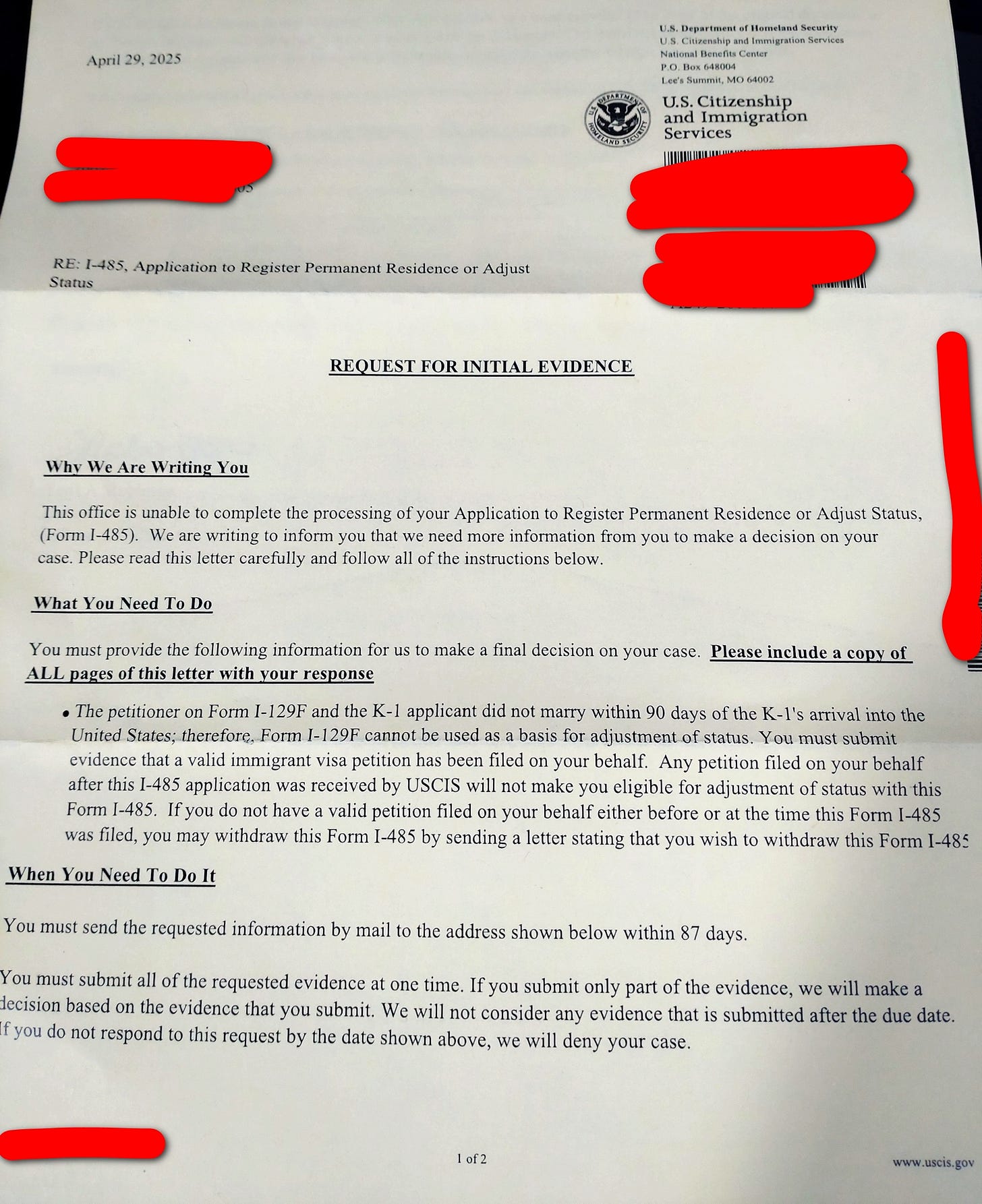The American Immigration System is Costly, Outdated, and Full of Delays. Here is our story
More than 2 years, 100 hours of research, 500 pages of documents, and $6,000 in expense, and still no green card.
Before we start, a bit of context of me, I’m a white American dude with no family ties outside of America. Before starting this journey, I had little knowledge of the immigration system.
This is our story of everything we learned during the journey, step by step, and explained in a way to help educate others what the process is like. To start your own journey, I highly recommend www.visajourney.com
K1 Visa
Back in 2022, I was single and on various dating apps. One day, someone liked one of my photos on Boo Dating. So I checked her profile and she was from Malaysia. I already had an online friend from Malaysia, so I knew a little bit about the country, so I message her. We talked and soon started dating. 2 months later I bought plane tickets, and 2 months after that, I was in Malaysia.
www.youtube.com/shorts/M4t2r_nPDLQ
A few months later in July 2023, me and Ida get engaged and start the immigration process by preparing to apply for the k1 and k2 visa. The k1 visa is the fiance visa. Its the visa popularized in mainstream media by the show “90 day fiance”. The k2 visa is for children of the k1 beneficiary.
I’ll be using the terms “beneficiary” and “sponsor”, as these are the terms the USCIS (United States Citizenship and Immigration Services) uses. Beneficiary in this context refers to the immigrant, and sponsor refers to the American citizen.
The k1/k2 visa form is officially called i-129f. It (at the time) cost us $535 to file the form. The form is 13 pages long and must include passport-style 2x2 inch photos, along with proof of having met in person and proof of relationship. This all has to be printed out and physically sent through the mail.
This is where the “outdated systems” part really comes to play. Its [current year] and, for some reason, USCIS is unable to process digital applications? Every single document in the packet is a copy or printout. I can pay my taxes online, but I can’t fill out a form online? Sending by mail costs more money, takes more time, and can get lost in transit. You may think this is a minor complaint, but this will not be the only form that has to be sent by mail.
After we sent the packet to USCIS, we waited. We waited for months. What happened was that during covid, travel was restricted, and this (speculation on my part) caused current couples to delay their applications and encouraged more single people to date online (since there was less in person socializing). Whatever the true reason, after covid, there was a HUGE backlog of k1 applications between ~2021 and ~2023. What used to take just ~90 days to process was now taking over 400 days to process.
During this wait, we wanted to see each other again. We wanted her to come to America to visit, but there was an issue. An American can just get a passport, buy a plane ticket, and visit Malaysia. For Malaysians visiting America, its different. Malaysians must apply for a tourist visa. Compared to citizens in some countries like China or Mexico, its relatively quick and easy for a Malaysian to get a tourist visa to America, but its not guaranteed. A Malaysian friend of mine wanted to visit her boyfriend in America. She paid the $185, waited ~2 weeks for the interview, drove an hour to the embassy for the interview… and she was denied. If you mention you are wanting a tourist visa to visit a loved one, you’ll almost always been denied. They view you as a high risk of overstaying your visa unless you can prove very strong connection to your home country.
Because of this, we felt that her visiting me in America wasn’t likely, and we didn’t want to waste $185 trying to apply for the tourist visa.
So in early 2024, I took another trip to Malaysia, but this time with my parents so my family can meet her family.
While in Malaysia, we checked the status of the application and it finished processing! It took 211 days. The next step was for the government to send the documents to the embassy in Malaysia and receive instructions from the embassy regarding the next steps and setting up an interview date.
We thought we were getting close to receiving the visa, but we weren’t. We weren’t even half way there yet.
Once the embassy in Malaysia received the packet (This took several week, as it was sent by mail from the US government), we were emailed a checklist of tasks needed to be completed before we could schedule the interview. The tasks included; completing DS-160 forms (2x since she and her daughter are both applying), completing I-134 (Declaration of Financial Support), obtain certified translations of birth certificates, evidence of relationship/engagement, obtaining a medical exam/report, obtaining a police record of good conduct, and to compile all of this into a single envelope (physical) and pdf (digital).
The DS-160 form is completely online. The US government DOES have the technology to process immigration forms online! Why every single other form requires physical printouts, but this form doesn’t, remains a mystery to me.
But this isn’t a modern website. This is like going from the pre-computer days to 1999 because the website is both old and barely functional. The website renders at 4:3 and we often ran into issues trying to submit the forms. DS-160 is a LONG form, taking over an hour to fill out. It took us closer to 2 hours per form (remember we had to fill it out twice) because of all the technical issues. You’d think a simple text web form would be a solved problem, but I guess the US government is still figuring it out.
The i-134 is a form I have to fill out that is essentially me promising to financially support the beneficiary so that she does not become a “public charge”. Lets diverge for a moment to discuss what it means to be a “public charge”.
I don’t really know.
What, exactly, constitutes someone being a “public charge” isn’t entirely clear. Its clear they are not eligible for welfare programs such as SNAP, but it doesn’t mean they are ineligible for any government program. For example, her daughter can not only attend public school, but can also receive free meals at school. Which government programs they can and can’t take advantage of varies from program to program, and its often not clearly define. Often, a program will say “available to some non-citizen with certain valid visas” without actually detailing which visa is acceptable.
So back to the actual form.
I was required to provide both a digital and physical copy of the entire packet. The packet included the form itself (13 pages), along with evidence of income. I was required to supply an entire year of bank statements, proof of employment, my latest tax return, and records of my other liquid assets (mostly stocks). This ended up being around 60 pages of documents.
This form is only valid between now and until we get married. After we get married, we have to fill out a different, but very similar form promising financial support. So that means printing and compiling all the same documents for a 2nd time. The only substantive difference between form i-134 and i-864 is that the first one required I show I have 100% above poverty income for everyone in the household (3), and the second form requires I show I have 125% above the poverty income.
The birth certificate translation, evidence of relationship, and record of good conduct, were trivial. It took some time and money, but nothing much of note. It was around $20 total.
Obtaining a medical exam/report was not trivial. There were so many complications at this step that it is genuinely hard to follow.
For someone healthy on no prescriptions, this step is quick and simple. What they’d needed is their medical records, required vaccines, and to get a physical. But for Ida and her daughter, they needed a medical report that explains their needs for prescriptions while also demonstrating that they are in stable conditions. Anyone on anti-depressants or a history of self harm has a risk of being denied the visa at this stage. Part of the purpose of the medical report is to demonstrate that the beneficiary is not a harm to herself or others around her. People HAVE been denied at this stage.
For Ida, she had been diagnosed with depression and went to a few sessions of therapy. She had a history of self harm in her teenage years, but nothing recent. We thought it wouldn’t be serious enough to deny her visa, but we couldn’t be sure.
Over the next month, she collects her medical records and schedules the appointments she needs. She talks to the hospital and they tell her it will be up to 30 working days until the medical report is completed. Waiting an additional 30 working days is more than we hoped, but we wait. ~35 days later (~30 business days), she gets a call from the hospital and they tell her its ready. She picks up the report. She then takes it to the clinic that the embassy specifies she must go to to complete the medical exam, but the clinic looks at the medical report and tells her it wasn’t filled out correctly. A doctor wrote the report, when it was suppose to be a specialist who should write the report. We were flabbergasted. It was extremely painful to learn that, due to a mistake by the hospital, we would have to wait another 30+ days apart.
Ida goes back to the hospital to request the proper medical report from the specialist. The first report was RM40, but this report is RM80 (~$20). They again tell us it will take ~30 working days until the report is finished.
Due to the multiple holidays and the specialist getting sick, it took a full 2 months for the report to be completed. Once she picked up her report, she was able to schedule a medical exam for the following week. It cost a combined ~$380 for both of their medical exams. After that was all complete, we were able to reply to the email from the embassy with all the requested documents.
From the date the i-129f form was processed (referred to as “Notice of Action 2” or NOA2), to the date that we gathered all the documents to send to the embassy is 8 months. It is now November of 2024.
The interview can now be scheduled. We spend a few hours navigating the website to schedule the interview. There are multiple different pages to navigate through. She has to create an account and fill out several pages of forms. Some pages are confusing, such as when it asks for “immigration type”.
K1 is a weird visa that is both an immigrant visa AND a non-immigrant visa. Sometimes, when navigating government websites or forms, you must input the k1 visa as a non-immigrant visa. Other times, its categorized as an immigrant visa. It is officially a non-immigrant visa. But it is typically listed under immigrant visas. So whether the US government categorizes it as an immigrant or non-immigrant visa just depends on the mood of the government worker that day, I guess.
Once that is figured out, we can select the date. The next earliest available date is around 3 weeks away, in December. We pick the date and pay the fees. The fee is $265 per person, which is $530 for both Ida and her daughter.
Its December 3rd, day of the interview. They arrive to the embassy and wait for several hours until it is their turn to be interviewed. She brings a packet of documents requested by the embassy (its all documents they have already been sent, but they asked for physical copies too) to the interview. Its a short and quick interview. They ask her a few questions, and she is approved! She doesn’t receive her visa right away, she has to wait about a week to pick up the visa at a different office.
The time between submitting the application and receiving the visa was 498 days.
With the visa in hand, we can book the flight. The flight is booked for December 24th and costs a total of $2,041 (~$1,150 for adult ticket, ~$850 for child ticket). The flight, including layovers, is over 26 hours long.
The first layover in America is in Houston, TX, which is considered her port of entry. This is where she officially enters the US and goes through immigration to get her passport stamped with the K1 visa. After a short, but mildly aggressive interview, the immigration officer stamps her passport with the k1 visa and reiterates that she must get married within 90 days.
After that, they get back onto the plane and land in Huntsville, Alabama on the night of December 24th.
90 days to get married
The first thing it was recommended that we do according to the guide we were following was to wait a week and then apply for a social security number. We want to do this before getting married since it will make things simpler. Its complicated to explain why, but some people can run into issues getting a social security number after marriage due to the name change and other reasons. So, doing what was suggested, we went to the local office and applied for a SSN. It was free.
They told us it would take 2 to 4 weeks, but the weeks go by and no updates. We call back, both the local office and national office, and they tell us the Department of Defense is processing our application, and it could take 6 weeks or so. 6 weeks go by and we call back and its the same thing. Its now over 8 weeks and we get no new answers when calling back.
We are also running out of time with the visa expiring soon. With just one week until the visa expires, we can’t wait any longer and we decide to get married. We get married at the library (they charge only $1 to certify the paperwork), and had the documents recorded at the courthouse the next day. We had 5 additional certified copies of the marriage certificate made for future use. This cost an extra $10.
Applying for Adjustment of Status (Green Card)
Its now March. We have a lot of forms we have to submit. We already started working on the forms earlier, but now its time to finish them and submit them asap. There is an issue though, something I overlooked and didn’t realized until after we got married. Their visas were the k1 and k2 visas, but once they got married, their visas ended, since the purpose of the visa is just to get married. I knew and understood that part. What I didn’t fully understand is what their immigration status immediately after that was. It turns out… they don’t have one.
After people on the k1 visa get married, they are officially considered “out of status”. This means they officially have no protections and could be deported at any moment for any reason.
This bears repeating. My wife and step daughter, who we collective spent thousands of dollars on travel and immigration fees to immigrate here legally, is temporarily left with no immigration status and no protection from deportation. Even after we submit the green card application, she will still be considered out of status, but will be considered in a state of “authorized stay”. Essentially what it means is she is in immigration purgatory. Neither of legal status, nor required to leave. Authorized to stay only while the green card application is pending.
But we haven’t submitted the application yet.
Having realized how urgent it is we submit the application asap, we rush to finish filling out the forms and printing all the required documents. Again, this ALL has to be printed out and physically sent through the mail to USCIS. This is especially problematic as each day the application is moving through the mail system is another day they are here with questionable legal status. A single interaction with a police officer for any reason, including being the passenger during a traffic stop, can result us being forcibly separated.
We finish filling out all the forms, gathered all the supporting documents we need, and go to the library to get everything printed. It totaled over 100 printed pages, costing us around $17.
We put it in a package and rushed to ship it out. We paid $12 for priority shipping.
The forms we submitted were:
Two i-485, Application to Register Permanent Residence or Adjust Status, which cost $1,400 for the first one and $950 for the second one (for her daughter);
Two i-693, Report of Immigration Medical Examination and Vaccination Record, which cost nothing;
One i-765, Application For Employment Authorization, which cost $260;
One i-864, Affidavit of Support, which cost nothing;
Three g-1450, Authorization for Credit Card Transactions, which cost nothing.
That puts the total fees for these applications at $2,650.
With this all complete, we just wait. We expect the next step to be for them to have their biometrics taken, worth authorization approved, and then later the green card approved (after an interview). That is what is suppose to happen.
REQUEST FOR INITIAL EVIDENCE
On May 3rd, we receive a “REQUEST FOR INITIAL EVIDENCE” (RFE) letter from USCIS. It states “The petitioner on Form i-129F and the K-1 applicant did not marry within 90 days of the K-1's arrival into the United States; therefore, i-129F cannot be used as a basis for adjustment of status.”
What?
We DID get married within 90 days! We submitted certified copies of the marriage certificate with the dates! How frustrating that USCIS is delaying our case because of a mistake they made. The only mistake that we made that we could find after talking to some people about it is that on page 5, item 2, of form i-485, we didn’t include the receipt number in the box. BUT, we DID include the actual receipt. What is the receipt number? Great question! Its probably why we didn’t put anything since we didn’t know. Turns out its the number related to the letter we received stating that the k1 visa was approved. But we included a copy of the k1 acceptance letter, so they had that number if that was the issue. We don’t know for certain why USCIS thinks we didn’t get married within 90 days, but we gathered and resubmitted evidence of our marriage within 90 days. We included the certified marriage certificate, page 5 with item 2 filled in, and signed statements that we married within 90 days.
We paid around $1 printing documents at the library and $7 to ship the package.
The letter wasn’t a denial, so simply responding to the letter should be enough, but the application is paused until they receive and process our response. This, again, puts my wife and step daughter in jeopardy to possibly being jailed or deported at whim for any reason, despite doing everything legal and right.
For now, all we can do is wait.
Biometrics
The same week as receiving the RFE, we get a letter informing us that their biometrics appointment is scheduled for 8am in Birmingham, AL. This is around a 1.5 hour drive, so we don’t love that its so early, but its not the end of the world. The appointment should be quick, all they need to do is take fingerprints and photos.
We get there at around 7:50am and wait in line. It went mostly smooth for us, but other people had problems. For some reason, you have to bring the letter with your appointment information on it. I guess the USCIS office doesn’t have their information on file, or it has to be brought in verify their appointment? But one odd thing I overheard was that they scheduled their appointment online. So for some reason, my family was assigned a date and time, but some people (presumably people who have different visas) can set an appointment online and choose their date and time? It doesn’t make sense to me why some people can choose their appointment while others can’t. To me, it just looks like more disorganization.
A few days later, we check our status online (we can do that at certain points in the process) and see the RFE was received and our case updated. Then a day or two after that we see their biometrics were added to their cases.
Where we are now
Its now June. We expected her work authorization to be complete by now, but the last update was 2 weeks ago and that was to inform us that the biometrics were added. Typically people receive their work authorization within 60 days, but we still have nothing.
We also can’t apply for a SSN now that her k1 visa expired. She has to wait until she receives her work authorization or green card. Her original SSN application before her k1 visa expired just… vanished. The social security office no longer has a record of it. So now she has to wait until she has a work authorization or green card until she can apply for her SSN again.
To our surprised, the green card application is ready for an interview!?! This, according to the averages over at visajourney, takes around 245 days, but for us, its only been ~90 days. We have not yet received the letter informing us of the interview date, but we expect to receive it any day now. I will update this article when that happens.
Once they receive their green cards and we get social security complete, the next step will be citizenship. To apply for citizenship, the applicant must first hold a green card for 5 years, or 3 years if married to a US citizen. So in our case, Ida and her daughter will be able to apply for citizenship in mid 2028. The process is similar to previous steps of filling out forms and paying fees, and then waiting a a few months.
To date, from the k1 visa to applying for permanent resident status, the total costs in fees, travel, and other related expenses total to $6,184.
It took 100s of hours to research and learn the immigration system so we could go through the process without paying for a lawyer. I spent hours writing this article trying to compress the knowledge I learned into an easy to digest way for others to learn what the journey is like.
If you would like to support me and my family, you can subscribe to my substack, or visit my online shop pokupoku.shop. You may also leave a tip through this page.




